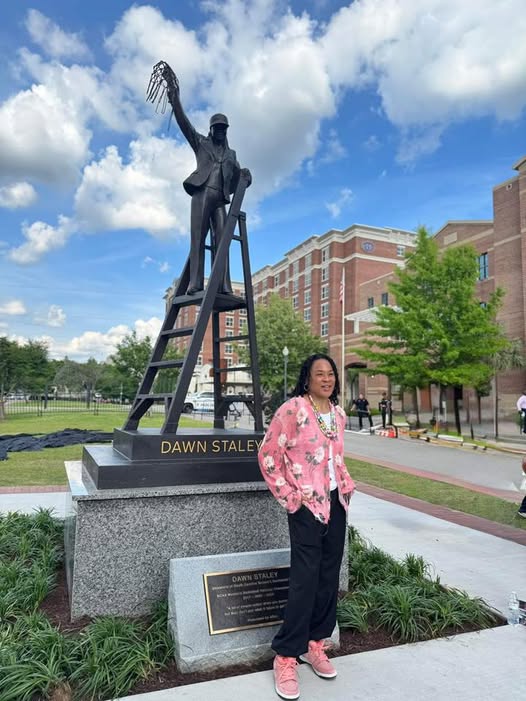
Historic Occasion: South Carolina Honors a Living Legend With a Startling Statue to Honor
In a groundbreaking move that underscores a commitment to rectifying historical omissions, South Carolina is set to unveil its first monument honoring an individual African American on the grounds of the Statehouse. This monumental tribute is dedicated to Robert Smalls, a man whose life story embodies courage, resilience, and an unwavering fight for justice.
Born into slavery in Beaufort, South Carolina, on April 5, 1839, Robert Smalls’ early life was marked by hardship and oppression. However, his indomitable spirit led him to seize an extraordinary opportunity that would change the course of his life and, eventually, history itself.
During the Civil War, Smalls was employed as a deckhand on the Confederate transport ship Planter. On May 13, 1862, with a daring act of bravery, he commandeered the vessel, navigating it past Confederate checkpoints and delivering it to Union forces. This audacious escape not only liberated Smalls and his crew but also provided the Union Navy with a valuable asset. His actions were instrumental in convincing President Abraham Lincoln of the potential of African American soldiers, leading to their enlistment in the Union Army.
Following the war, Smalls transitioned into a political career, becoming a prominent figure during the Reconstruction era. He served in the South Carolina Legislature and later in the U.S. House of Representatives, where he championed civil rights and worked tirelessly to secure educational opportunities for African Americans. His advocacy was pivotal in establishing South Carolina’s first free and compulsory public school system.
Despite the progress made during Reconstruction, the resurgence of white supremacist power in the late 19th century led to the erosion of many gains. Smalls continued to fight for equality, even as the political landscape became increasingly hostile.
The decision to erect a statue of Robert Smalls on the Statehouse grounds is a significant step in acknowledging the contributions of African Americans to the state’s history. The monument, designed by Atlanta-based sculptor Basil Watson, portrays Smalls in a dignified three-piece suit, reminiscent of his attire during his tenure in Congress. This portrayal not only honors his political achievements but also aligns with the aesthetic of other statues on the Statehouse grounds, ensuring that Smalls is recognized as an equal among historical figures.
The statue’s placement near the Statehouse’s visitors’ entrance is symbolic. It positions Smalls in direct view of the statue of “Pitchfork” Ben Tillman, a notorious segregationist and white supremacist. This deliberate juxtaposition serves as a powerful statement, challenging the legacy of oppression and elevating Smalls’ contributions to the forefront of South Carolina’s history.
The journey to this moment has been long and fraught with challenges. For years, proposals to honor Robert Smalls met with resistance. However, in 2024, momentum shifted. A bill to erect the statue passed unanimously through the state House and Senate, a testament to bipartisan support for recognizing Smalls’ legacy. The establishment of the Robert Smalls Monument Commission marked the beginning of the planning process, which included selecting a design, determining the statue’s location, and securing funding.
Lawmakers and community leaders have expressed their enthusiasm for the project. Representative Brandon Cox, who played a pivotal role in advancing the bill, remarked, “The man has done so many great things, it’s just a travesty he has not been honored until now.” His sentiments reflect a collective acknowledgment of the importance of rectifying historical oversights.
The erection of Robert Smalls’ statue is more than just the placement of a figure on a pedestal; it is a deliberate act of historical acknowledgment. South Carolina’s Statehouse grounds have long been home to monuments commemorating various figures, including several Confederate leaders. However, until now, no individual African American has been honored in this manner. This oversight has been a point of contention for many who believe that the state’s history is incomplete without recognizing the contributions of African Americans.
The new monument rectifies this omission, providing a more inclusive narrative of South Carolina’s past. It serves as a reminder that history is not monolithic and that the stories of all individuals, regardless of race, deserve recognition. By honoring Robert Smalls, South Carolina takes a significant step toward healing and reconciliation.
Beyond its symbolic significance, the statue of Robert Smalls is expected to have a profound educational and cultural impact. As visitors approach the Statehouse, they will encounter a figure whose life story exemplifies the ideals of freedom, justice, and perseverance. The monument will serve as a catalyst for discussions about the state’s complex history and the ongoing journey toward equality.
Educational programs and initiatives are being developed to complement the statue, ensuring that Robert Smalls’ legacy is taught to future generations. Schools and community organizations will have access to resources that highlight his contributions, fostering a deeper understanding of the importance of his actions.
The unveiling of Robert Smalls’ statue is a significant milestone in South Carolina’s journey toward reconciliation. It acknowledges the injustices of the past while celebrating the resilience and achievements of those who fought for a more just society. The monument stands as a testament to the power of one individual’s actions to inspire change and to the collective efforts required to build a more inclusive future.
As the statue is unveiled and visitors gather to pay homage, it will undoubtedly serve as a poignant reminder that history is not just about the past but also about the lessons we carry forward. Robert Smalls’ legacy is a beacon of hope, demonstrating that even in the face of adversity, the pursuit of justice and equality remains a worthy endeavor.
The decision to honor Robert Smalls with a statue on the South Carolina Statehouse grounds is a historic occasion that reflects a commitment to acknowledging the full spectrum of the state’s history. It is a recognition of the contributions of African Americans and a step toward rectifying past omissions. As the statue stands proudly, it will inspire future generations to continue the work of justice and equality that Robert Smalls so valiantly championed.





